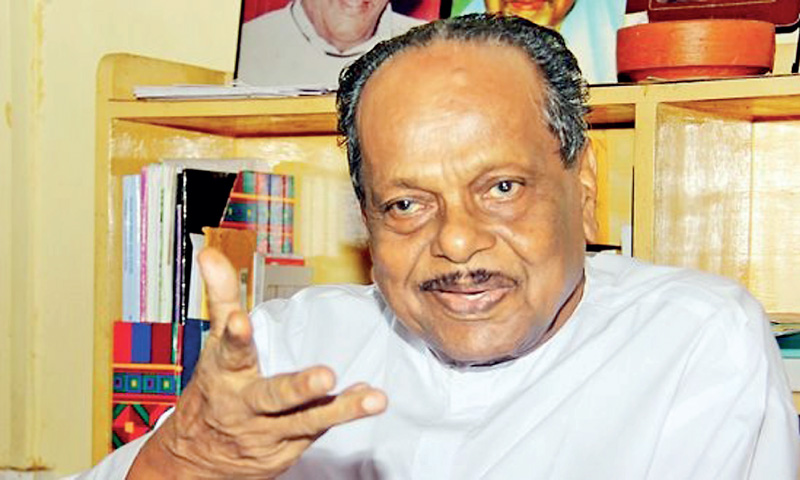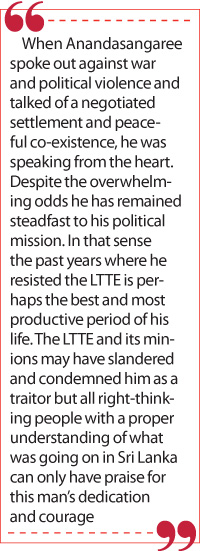Saturday Dec 06, 2025
Saturday Dec 06, 2025
Wednesday, 16 June 2021 00:20 - - {{hitsCtrl.values.hits}}

Veerasingham Anandasangaree, a man of dedication and courage
 The Tamil United Liberation Front (TULF) formed on 14 May 1976 contested the 21 July 1977 Parliamentary Elections adopting a secessionist platform. The TULF demanded a separate state for the Sri Lankan Tamils named Tamil Eelam comprising the Northern and Eastern Provinces of the island.
The Tamil United Liberation Front (TULF) formed on 14 May 1976 contested the 21 July 1977 Parliamentary Elections adopting a secessionist platform. The TULF demanded a separate state for the Sri Lankan Tamils named Tamil Eelam comprising the Northern and Eastern Provinces of the island.
The TULF contesting under the sun symbol sought a mandate for Tamil Eelam at the 1977 Parliamentary poll that was conducted on an electorate basis under the first past the post winner system. The election to the double-member constituency of Pottuvil was not held at the July polls due to a candidate’s death. The postponed Pottuvil poll was held some weeks later.
The TULF scored a resounding victory in the Tamil-dominated Northern Province by winning all 14 electorates in the north. In the Tamil majority Eastern Province, the TULF won in four out of the five constituencies where a Tamil MP could be elected. The TULF lost in Kalkudah where the United National Party (UNP) candidate K.W. Devanayayagam won. All the TULF Muslim candidates contesting Kalmunai, Sammanthurai, Mutur and in Puttalam were defeated.
Thus the TULF won 18 of the 19 “Tamil” electorates it contested and became the second largest party in the 1977 Parliament. While the UNP led by J.R. Jayewardene obtained 141 seats in a 168-member Parliament, the Sri Lanka Freedom Party (SLFP) of Sirimavo Bandaranaike lost ignominiously, getting only eight MPs. The TULF with 18 MPs became the chief Opposition party and its Secretary-General Appapillai Amirthalingam made history took as the first Tamil Leader of the Opposition.
Two TULF MPs – M. Canagaretnam (Pottuvil) and C. Rajadurai (Batticaloa) – defected to the UNP Government in 1977 and 1979 respectively. Two other MPs – C. Kathiravelupillai and T. Thirunavukkarasu – died of natural causes. M. Aalalasuntharam and Dr. Neelan Tiruchelvam were appointed in their place as Kopay and Vaddukkoddai MP respectively.
The UNP Government brought in the sixth Constitutional Amendment disavowing separatism in August 1983 in the aftermath of the July 1983 anti-Tamil pogrom. The TULF that had been elected on a secessionist platform took up a principled position and refused to take oaths in terms of the 6th Amendment to retain its MP posts. All 16 TULF MPs forfeited their seats in Parliament. It was only after the Indo-Lanka Agreement which the TULF accepted with reservations that the TULF re-entered Parliament by contesting the 1989 elections.
Of the 18 TULF MPs originally elected in 1977 and the two Parliamentarians appointed subsequently, only three are among the living now. They are nonagenarian Chelliah Rajadurai (Batticaloa) and octogenarians Rajavarothayam Sampanthan (Trincomalee) and Veerasingham Anandasangaree (Kilinochchi).
Rajadurai who crossed over to the UNP from the TULF now lives in blissful retirement shuttling between Malaysia, India and Sri Lanka. Sampanthan is still an MP representing the Trincomalee District. He is no more in the TULF but is acknowledged as the Leader of the Tamil National Alliance (TNA).
Anandasangaree is yet in active politics but is no more an MP. Moreover it is only Anandasangaree who still remains loyal to the TULF and gives leadership to the party which is now a shadow of its former self. It is Veerasingham Anandasangaree who is the livewire of the TULF as its Secretary-General.
Anandasangaree, generally known as Sangaree, celebrated his 88th birth anniversary on 15 June. This column therefore focuses on the TULF Leader this week. I have written extensively about him in the past and will rely on some of those writings for this article.
 Early years
Early years
Prior to becoming the TULF Secretary-General, Sangaree has served as both the Senior Vice-President and President of the TULF.
When Anandasangaree was elected unanimously as President of the TULF in June 2002 before the TNA being formed, I wrote an article in The Sunday Leader titled ‘Former Trotskyite now leads the TULF’.
I ended the article with the following paragraph – “Anandasangaree takes over the TULF reins at a critical phase in the island’s politics. His party itself has accepted the overall dominance of the Liberation Tigers of Tamil Eelam (LTTE). Given Sangaree’s fiery independent streak it is very likely that the TULF while backing the LTTE politically would also try and retain some functional autonomy. That however depends on the extent to which his party colleagues will cooperate with him. If such enlightened unity and support is not rendered the ex-Trotskyite may very well be presiding over the Swansong of the TULF.”
What I referred to in that article was proven true subsequently. Sangaree did fall foul of the LTTE for trying to uphold the independence and dignity of the TULF. His erstwhile colleagues let him down badly and hitched their wagon to the LTTE star. The bulk of the TULF transformed into the TNA and was re- born as an Ilankai Thamil Arasuk Katchi (ITAK) avatar. The original TULF became a caricature of its former self.
In the case of Anandasangaree vis-à-vis the ITAK/TNA there was another dimension too. It was the issue of subservience to the LTTE which resulted in the parting of the ways for Sangaree and his former party colleagues. The party acting on orders of the LTTE expelled Sangaree in an act described as “dead corpses walking” by the UTHR (J). But Sangaree to his credit did not cave in meekly. He fought against his expulsion in courts and also to retain control of the TULF. Finally Sangaree was the victor in the legal battle. This resulted in the TNA contesting under the ITAK symbol of ‘house’ as the Court order prevented the TNA using the ‘sun’ symbol.
Anandasangaree and the LTTE
Anandasangaree did not roll over and play dead when the LTTE intimidated him. He remained politically active and continued to criticise the LTTE. He wrote numerous public letters to LTTE supremo Veluppillai Prabhakaran advising him to change his ways, stop the war and go in for a negotiated settlement.
This was indeed a rare occurrence in Tamil politics as very few Tamil nationalist leaders with a democratic political background and roots did so (Douglas, Karuna, Pillaiyan, etc. are former armed militants). Sangaree earned the respect and admiration of many including a very large segment of the majority community by this action.
Ultimately Sangaree was proven right. The LTTE was defeated militarily. Prabhakaran dragged the Tamil people down with him and has caused irredeemable harm. The political mantle once again acquired a democratic form after the Tamil National Alliance began contesting elections and winning them without being propped up by the LTTE.
But the problem here was that the impact and influence of “Tigerism” (to borrow a description made famous by Ram Manikkalingam) still lingers on even in the absence of the LTTE on the island. The LTTE structures abroad are yet active and the global Tamil diaspora exerts much influence over mainstream Tamil politicians and media in the island.
What has been increasingly discernible against this backdrop is a marked reluctance by Tamil political leaders and opinion makers to admit the destructive role played by the LTTE in worsening the tragic Tamil plight in Sri Lanka. Instead of an honest introspective self-appraisal, the emphasis is on laying the blame elsewhere. The negativity of the LTTE is ignored, overlooked or glossed over.
In such a context the position of Anandasangaree is akin to that of being a prophet not recognised in his own country. What Sangaree warned about the LTTE and the Tamil people has come true but the Tamil political elements who played second fiddle to the LTTE are unwilling to even grudgingly accept that.
Instead of admitting their guilt and praising Sangaree for his courage in speaking truth to the LTTE when Tiger power was at its zenith, these politicians and so-called media personnel resent the fact that Sangaree was right and they were wrong. There would never be proper admission and appreciation of his historic role in standing up to the LTTE as by doing so they would only be exposing their own deficiencies and shortcomings. Hence they continue to ridicule him.
Despite this step-motherly treatment towards Sangaree by sections of fellow Tamils, Anandasangaree’s defiance of the LTTE in this respect was an act admired widely. The UNESCO award bestowed upon him illustrates this. In 2006 Sangaree was the recipient of the UNESCP-Madanjeet Singh Prize for the Promotion of Tolerance and Non-Violence.
The courage of his convictions
Even more important than the international laurels was the regard and respect he earned among the Sinhalese community. Lakshman Kadirgamar was part of the Government without a nationalist Tamil political history. Anandasangaree however was steeped in Tamil nationalist politics.
Here was a Tamil political leader from a mainstream Tamil political party daring to criticise the Tigers at a time when most of his colleagues were mortgaging their body and soul to the LTTE in return for a mess of pottage. Such a phenomenon was indeed dazzling and Sangaree had the trust and affection of many Sinhalese. Some even wanted to make him Governor of the north or east at one time but Sangaree was not so inclined.
His critics within the Tamil polity accused him of being a political stooge of former President Mahinda Rajapaksa but Sangaree with the courage of his convictions continued upon his chosen course undeterred. He retained his independence and never toed the Government line although it was necessary to avail of State protection because of the Tiger threat. Had not Sangaree been given protection he could have been killed by the Tigers long ago.
Anandasangaree proved his critics wrong after the fall of the LTTE. Instead of singing hosannas to the victors and seeking rewards from the Government, the man remained with the Opposition, pointing out the shortcomings and blunders made by then President Mahinda Rajapaksa in dealing with reconciliation issues.
The finest hours in Sangaree’s political life
The historic role played by Sangaree in defying the Tigers cannot be discounted or underestimated. Anandasangaree’s contribution in this regard is of two phases.
The first was the one from the early ’90s of the 20th century to the early years of the 21st century. This was the time when he functioned as Senior Vice President of the TULF and provided yeoman service in keeping the party ticking in the face of several leaders being killed by the LTTE. The second phase is the one where he was President of the TULF and fought against overwhelming odds by defying the LTTE till its defeat in May 2009. These phases are the finest hours in Sangaree’s political life.
As stated before, at a time when the TULF was under grave threat from the LTTE, it was Sangaree who rallied the party around and provided moral strength to withstand the pressure. He planted himself in Jaffna and masterminded the Jaffna Municipal poll campaign in 1998. It was this success which helped the TULF restore lost prestige and regain a firm footing in Jaffna politics again.
Then the LTTE killed two TULF Mayors, Sarojini Yogeswaran and Pon Sivapalan and a mayoral aspirant, Mathimugarajah. Again it was Sangaree who held the party together and kept running the Jaffna Municipality with the help of his erstwhile protégé Nadarajah Raviraj as Acting Mayor. If Raviraj had declined the mayoralty or been killed, then Sangaree was prepared to become Jaffna Mayor himself and defy LTTE diktat then.
I was also witness to another incident in Toronto in 2000 which illustrated the man’s courage and dedication to the party. Sangaree was in Canada when elections to Parliament were announced in Sri Lanka. He was preparing to return and take charge of the election campaign. This was a time when the TNA had not been formed and the TULF faced danger from both the LTTE and EPDP. His daughter was pleading with him not to go back but stay on in Canada. Sangaree refused and kept on repeating, “Whatever the danger I must face it. If we don’t contest that is the end of our party.”
Sangaree’s courage and determination
Sangaree’s problems with the LTTE began because he stood up for the party and discouraged the Tigers from interfering too much in TULF matters. When Anton Balasingham made insulting remarks about the TULF, it was Sangaree then in Canada who issued an effective rejoinder. The TULF rank and file was overjoyed by Sangaree’s defiance.
The late Raviraj stated publicly at the TULF meeting that it was Sangaree who salvaged the self-respect of the party. This was the beginning of the dispute between the LTTE and Sangaree. Yet when the LTTE exerted pressure, the TULF bigwigs shamelessly threw Sangaree to the wolves, or in this case the Tigers. Some of these bigwigs were the ones who meted out humiliating treatment to Sangaree later.
If Sangaree’s valiant fight within the TULF was a courageous feat the man displayed a rare fighting ability and tenacity after his electoral defeat in 2004. Instead of slinking into political oblivion with tail tucked between his legs or going out to pasture with his children in Britain, Canada or Denmark, Anandasangaree chose to remain in Sri Lanka and fight it out. Instead of keeping mum or adopting the path of least resistance, Sangaree opted to take the bull by its horns – or the tiger by its jaws.
Sangaree has always been a brave fighter. Contesting as a 26-year-old man from Jaffna against UNP Colombo Mayor V.A. Sugathadasa in 1959. Parachuting as an unknown outsider into the unknown Kilinochchi in 1960 as LSSP candidate. Going against his two Tamil Congress Parliamentary colleagues and voting against the 1972 Constitution. Combatting the “powerful” campaign of SLFP Tamil Cabinet Minister Chelliah Kumarasuriar in Kilinochchi in 1977. Engaging in bitter acrimony with fellow TULF members over his demand to carve out Kilinochchi as a separate district from that of Jaffna. Defying the LTTE during Jaffna Municipal elections and its aftermath. Resisting his ouster from the TULF boldly instead of caving in to Tiger pressure, etc. are all indicators of Sangaree’s courage and determination.
His finest hours however were during his septuagenarian years. Sangaree struggled to keep the party alive amidst great adversity. He sold his jeep, lands and some other personal assets to keep the party afloat. Some loyal TULF members, supporters and personal admirers chipped in to provide additional finances. He also fought many legal battles relating to politics.
What was remarkable about the man was his dogged determination to articulate his viewpoint and advocate a negotiated settlement to the ethnic crisis on federal lines. While there were many voices within the Tamil nationalist spectrum and among the human rights community to condemn the State and its minions, there were comparatively few voices amidst Tamils who criticised the LTTE. The Tigers were a holy cow for most Tamils and few Tamils dared to differ let alone criticise it. It became in the words of famed Tamil poet Subramania Bharathy the “Pesaap Porul” or unspeakable theme.
But not for Sangaree. He waded into those dangerous waters without hesitation. He was branded traitor and a knave and as a man who sold out and as one who has sold his soul, etc. Yet he firmly stood his ground, continuing to do what he thought was right. By doing so he touched upon many issues that were “untouchable” among Tamil political and media circles. Sangaree also succeeded in giving voice to the unexpressed sentiments of the silenced Tamil majority. He was often the voice of the voiceless Tamils.
Abhorrence of war and espousal of non-violence
His abhorrence of war and espousal of non-violence stemmed very much from very personal loss, suffering and pain. Sangaree has lost many relatives to political violence and terror. His elder brother Rajasangaree was the Chairman of Chavakachcheri Citizens Committee during the Indian Army period. Rajasangaree spoke out against Indian Army atrocities and was killed by the EPRLF on 26 October 1987.
Anandasangaree’s younger brother Gnanasangaree was killed in Kilinochchi by the LTTE for criticising the Tigers publicly. This happened on 10 February 1988. Two of Gnanasangaree’s sons spoke out publicly against their father’s killing. They were taken away by the Tigers for questioning. They never returned home.
Another brother Ganeshasangaree’s son was Yogasangaree. This nephew of Anandasangaree was elected as an EPRLF Member of Parliament for Jaffna District in 1989. On 19 June 1990 Yogasangaree was in Madras for an EPRLF meeting at Kodambakkam with Secretary-General Padmanabha. LTTE assassins suddenly entered and sprayed the hall with machine gun fire. Fourteen including Padmanabha and Yogasangaree died.
On 7 July 2005 Islamic terrorists set off human bomb explosions in subway trains and a surface bus in London. One of those killed was a young girl of Sri Lankan origin. She was Sayanuja, the daughter of another brother of Anandasangaree named Parathasangaree.
So when Anandasangaree spoke out against war and political violence and talked of a negotiated settlement and peaceful co-existence, he was speaking from the heart. Despite the overwhelming odds he has remained steadfast to his political mission. In that sense the past years where he resisted the LTTE is perhaps the best and most productive period of his life.
The LTTE and its minions may have slandered and condemned him as a traitor but all right-thinking people with a proper understanding of what was going on in Sri Lanka can only have praise for this man’s dedication and courage. I wish “Sangaree Annan” well on his 88th birthday.
(D.B.S. Jeyaraj can be reached at [email protected])